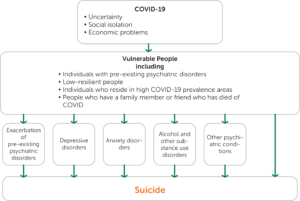Mental health issues have risen among adults during the COVID-19 pandemic. Hospitals and therapists are reporting an increase in suicides in nearly all age groups. A CDC report shows more than 40% of U.S. adults say they’ve had at least one mental health event with 11% reporting they have seriously considered suicide.
Suicide is complex, involving layers of risk factors, including biological and environmental ones. And it’s hard to know the exact factors involved in each situation but tackling known risk factors that are likely to be exacerbated by the pandemic is crucial. These include depression, post-traumatic stress disorder, hopelessness, feelings of entrapment and burdensomeness, substance misuse, loneliness, domestic violence, child neglect or abuse, unemployment, and other financial insecurity.
Best Practices can include:
- Leadership creating a culture of well-being
- Addressing high-turnover areas and identify toxic environments
- Launching awareness campaigns regarding signs and symptoms of suicide
- Training to build employees’ resources with stress management and resiliency tools
- Providing Peer Support utilizing both informal and formal initiatives
- Providing Mental Health and Crisis Resource Services ensuring people have access and know who to connect
— Read more in SWEAP Connections 2021 Workforce Impacts and Trends
Graphic is quoted from: “Impact of the COVID-19 pandemic on suicide rates,” QJM, Volume 113, Issue 10, October 2020, Pages 707–712, https://doi.org/10.1093/qjmed/hcaa202


